Notebook
-
 Science & Society
Science & SocietyCancer drug came from traditional Chinese medicine
Researchers looked to traditional Chinese medicine for cancer treatment clues 50 years ago. Today, synthetic versions treat a variety of cancers.
-
 Paleontology
PaleontologyT. rex look-alike unearthed in Patagonia
A new dinosaur species discovered in Patagonia has the runty forearms of a Tyrannosaurus rex, but is not closely related to the gigantic predator.
By Meghan Rosen -
 Astronomy
AstronomyMagnetic fields in sun rise at 500 kilometers per hour
Magnetic fields within the sun rise up no faster than about 500 kilometers per hour, suggesting that the movement of gas is responsible for bringing these fields to the sun’s surface.
-
 Animals
AnimalsThese lizards bleed green
Blood and bones turn naturally green in island lizards. Their evolutionary history still needs explaining.
By Susan Milius -
 Oceans
Oceans50 years ago, humans could pick the oceans clean
Scientists have long recognized that we might overfish the oceans. Despite quotas, some species are paying the price of human appetite.
-
 Animals
AnimalsNewly discovered big-headed ants use spines for support
Two newly discovered ant species provide new insights into spiny evolution.
-
 Animals
AnimalsTo prevent cannibalism, bring chocolate
If a date goes bad for a nursery web spider, a romantic gift can serve as a shield.
By Susan Milius -
 Health & Medicine
Health & MedicineU.S. lags in road safety
The U.S. tops the list of 19 high-income countries for deaths from motor vehicle crashes.
By Alex Maddon -
 Oceans
OceansUnderwater city was built by microbes, not people
Submerged stoneworklike formations near the Greek island of Zakynthos were built by methane-munching microbes, not ancient Greeks.
-
 Life
LifeArtificial hearing has come a long way since 1960s
Scientists envisioned artificial hearing 50 years ago. Today, they are working to make it superhuman.
-
 Animals
AnimalsTo zip through water, swordfish reduce drag
A newly discovered oil-producing organ inside the swordfish’s head gives the animal slick skin to swim faster.
-
 Physics
PhysicsSounds from gunshots may help solve crimes
Sound wave analysis may help forensic scientists figure out what types of guns were fired at a crime scene.
By Meghan Rosen